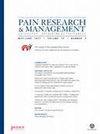Coping and Beliefs as Predictors of Functioning and Psychological Adjustment in Fibromyalgia Subgroups
IF 2.5
3区 医学
Q2 CLINICAL NEUROLOGY
引用次数: 2
Abstract
Objectives Research has pointed to two profiles of persons with fibromyalgia according to differences in functionality, thus distinguishing between functional and dysfunctional patients. The role of psychological factors underlying such clusters is unclear. This study aims to explore the contribution of pain beliefs and coping on fibromyalgia clustering. Methods A cluster analysis was performed to classify 238 women with fibromyalgia using the Fibromyalgia Impact Questionnaire and the Beck Depression Inventory as clustering variables. Cluster differences in physical functioning, depression, pain beliefs, coping, and age were then calculated (Student's t-test). Finally, a binary logistic regression was conducted to study the unique contribution of age, beliefs, and coping on cluster classification. Results Two clusters were revealed. Cluster 1 had a poor adaptation to fibromyalgia regarding physical functioning and depression. They generally embraced less adaptive beliefs (i.e., disability, harm, emotion, and requests) and coping strategies (i.e., guarding, resting, and asking for assistance). Cluster 2 showed a better adaptation to fibromyalgia and adopted more favorable beliefs (i.e., control) and coping strategies (i.e., exercise and task persistence). Cluster differences in age were significant but small. The backward binary logistic regression suggested a final model with six predictors (guarding, task persistence, harm, emotion, solicitude, and age) that explained 31% of the variance of group membership. Discussion. These results suggest that only a subset of psychological variables uniquely and independently contribute to functional/dysfunctional group membership. The results support the need to address psychological components in the management of fibromyalgia and point to a subset of preferred target beliefs and coping strategies.应对和信念作为纤维肌痛亚组功能和心理适应的预测因子
研究指出了纤维肌痛患者根据功能差异的两种概况,从而区分功能性和功能障碍患者。这种群集背后的心理因素的作用尚不清楚。本研究旨在探讨疼痛信念和应对在纤维肌痛聚类中的作用。方法采用纤维肌痛影响问卷和贝克抑郁量表作为聚类变量,对238例纤维肌痛女性患者进行聚类分析。然后计算身体功能、抑郁、疼痛信念、应对和年龄的聚类差异(学生t检验)。最后,采用二元逻辑回归分析了年龄、信仰和应对对聚类分类的独特贡献。结果发现2个聚簇。第1组在生理功能和抑郁方面对纤维肌痛的适应较差。他们通常接受适应性较差的信念(即残疾、伤害、情感和请求)和应对策略(即保护、休息和寻求帮助)。集群2对纤维肌痛表现出更好的适应性,并采取了更多的有利信念(即控制)和应对策略(即锻炼和任务坚持)。年龄群差异显著但较小。反向二元逻辑回归提出了一个具有六个预测因子(保护、任务持久性、伤害、情感、关怀和年龄)的最终模型,该模型解释了31%的群体成员差异。讨论。这些结果表明,只有一小部分心理变量独特而独立地影响了功能/功能失调的群体成员。结果支持在纤维肌痛管理中解决心理因素的必要性,并指出了首选目标信念和应对策略的子集。
本文章由计算机程序翻译,如有差异,请以英文原文为准。
求助全文
约1分钟内获得全文
求助全文
来源期刊

Pain Research & Management
CLINICAL NEUROLOGY-
CiteScore
5.30
自引率
0.00%
发文量
109
审稿时长
>12 weeks
期刊介绍:
Pain Research and Management is a peer-reviewed, Open Access journal that publishes original research articles, review articles, and clinical studies in all areas of pain management.
The most recent Impact Factor for Pain Research and Management is 1.685 according to the 2015 Journal Citation Reports released by Thomson Reuters in 2016.
 求助内容:
求助内容: 应助结果提醒方式:
应助结果提醒方式:


